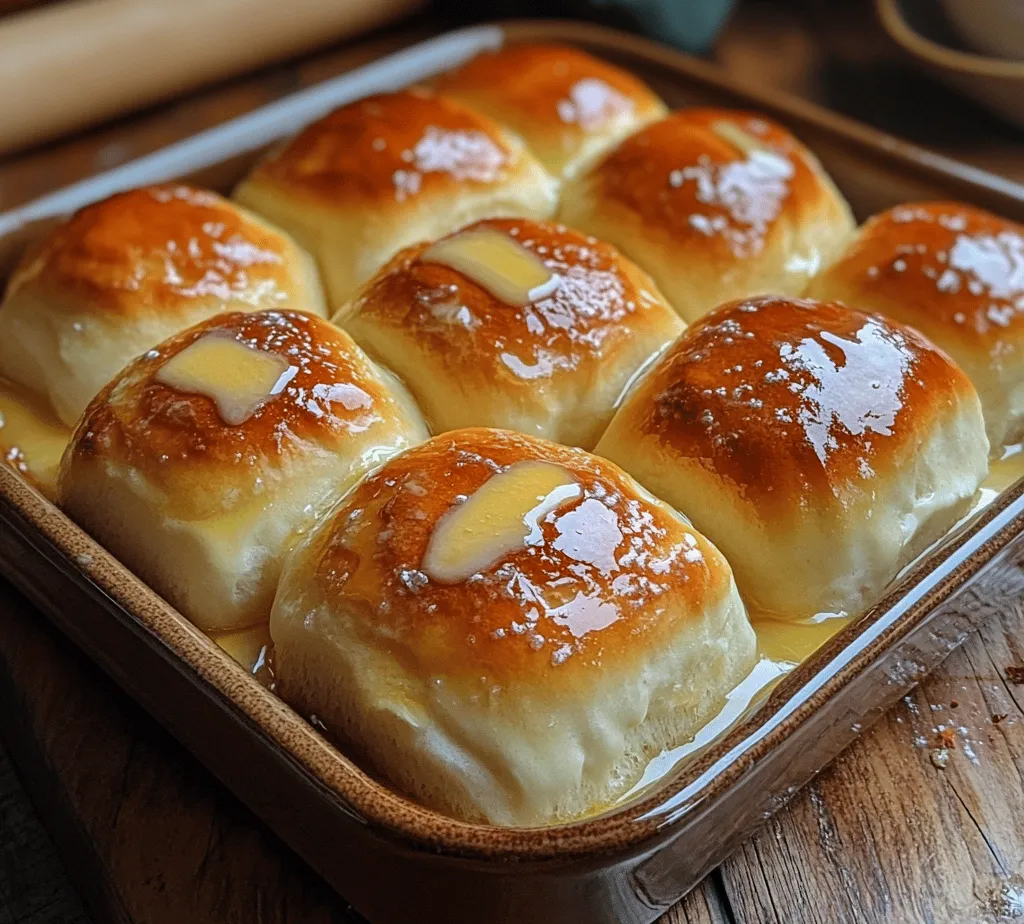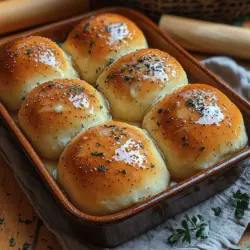Introduction
There’s something undeniably comforting about fresh, homemade dinner rolls. The aroma that wafts through your kitchen as they bake, the way they puff up to perfection, and the soft, pillowy texture are all part of what makes dinner rolls an irresistible addition to any meal. Whether served alongside a holiday feast, a simple weeknight dinner, or as part of a gathering with friends, homemade rolls elevate the dining experience. Among the many variations of dinner rolls, Fluffy Cloud Dinner Rolls stand out for their lightness and exceptional texture.
These rolls are not just a side dish; they are the kind of comforting indulgence that can bring people together around the table. Their soft, airy nature makes them perfect for sopping up gravy, slathering in butter, or even using as a base for sliders. The beauty of these rolls lies not only in their taste but also in their simplicity. With a few quality ingredients and a little bit of patience, you can create something truly special.
To achieve the best results, it is essential to use high-quality ingredients. Each component plays a pivotal role in developing the flavor and texture of your rolls. From the flour that provides structure to the yeast that helps them rise, every ingredient is critical. Let’s take a closer look at what makes these Fluffy Cloud Dinner Rolls a delightful addition to your culinary repertoire.
Understanding the Ingredients
All-Purpose Flour
Flour is the backbone of any bread recipe, and all-purpose flour is a versatile choice that provides the necessary structure and elasticity for our dinner rolls. When combined with water, flour forms gluten, which gives the dough strength and helps it hold its shape during rising and baking. For the best results, it’s advisable to measure your flour correctly and consider sifting it before use, as this can help aerate the flour and make it lighter.
Active Dry Yeast
Yeast is the magic ingredient that transforms a simple dough into fluffy rolls. Active dry yeast is a type of leavening agent that needs to be activated before use. When combined with warm water and sugar, it begins to ferment and produce carbon dioxide, which causes the dough to rise. Ensuring your yeast is fresh and properly activated is crucial for achieving the desired lightness in your rolls.
Granulated Sugar
Sugar serves two main purposes in this recipe: it helps activate the yeast and adds a subtle sweetness to the rolls. The yeast consumes the sugar, producing carbon dioxide and alcohol in the process, which contributes to the dough’s rise. A small amount of sugar enhances the overall flavor, giving the rolls a lightly sweet profile that complements savory dishes beautifully.
Salt
While it may seem counterintuitive, salt is essential in bread making. It enhances the flavor of the rolls and helps regulate yeast activity, ensuring a balanced fermentation process. Too little salt can lead to overly rapid rising, while too much can inhibit yeast growth. A careful balance is key to achieving perfectly risen and flavorful rolls.
Whole Milk
Whole milk adds moisture and richness to the dough, contributing to a tender crumb and a delightful flavor. The fat in the milk also helps to soften the gluten structure, making the rolls even fluffier. For best results, use milk at room temperature, as this aids in the fermentation process and ensures a smooth dough consistency.
Unsalted Butter
Butter is another crucial ingredient that imparts flavor and tenderness to the rolls. Unsalted butter allows you to control the amount of salt in the recipe, ensuring optimal flavor balance. When melted and mixed into the dough, it creates a rich, soft texture that’s simply irresistible.
Eggs
Eggs are a powerhouse ingredient in baking, providing richness, moisture, and structure to the dough. They help bind the ingredients together and contribute to the overall rise of the rolls. Using room temperature eggs in your dough will promote a smoother mixture and better incorporation of all ingredients.
Importance of Room Temperature Ingredients
Using room temperature ingredients is vital for the success of your Fluffy Cloud Dinner Rolls. Cold ingredients can slow down the activation of the yeast and lead to a dense texture. Allowing your milk, eggs, and butter to come to room temperature ensures that they mix evenly and contribute to the dough’s overall consistency.
Step-by-Step Instructions for Fluffy Cloud Dinner Rolls
Activating the Yeast
The first step in making Fluffy Cloud Dinner Rolls is to activate the yeast. This process is crucial, as it determines the success of your dough’s rise. Start by measuring out warm water (about 110°F or 43°C) into a small bowl. The water should feel warm to the touch but not hot, as excessive heat can kill the yeast.
Add a teaspoon of granulated sugar to the water and sprinkle the active dry yeast on top. Allow the mixture to sit undisturbed for about 5 to 10 minutes. During this time, the yeast will begin to feed on the sugar, and you should see a frothy layer forming on the surface. This bubbling action indicates that the yeast is alive and ready to work its magic in your dough.
Mixing the Wet Ingredients
Once your yeast is activated, it’s time to mix the wet ingredients. In a large mixing bowl, combine the warm milk and melted unsalted butter. Stir to combine, and then add in the frothy yeast mixture along with two room temperature eggs. Whisk together until the mixture is smooth and well incorporated. This step is essential for ensuring that the yeast is evenly distributed throughout the dough, allowing for an even rise.
Combining Dry Ingredients
Next, you will want to prepare the dry ingredients. In a separate bowl, whisk together the all-purpose flour and salt. This step helps to evenly distribute the salt throughout the flour and prevents clumping during mixing. Begin by adding the dry flour mixture to the wet ingredients in three parts, stirring gently after each addition. The goal is to combine the ingredients until a shaggy dough begins to form.
Tip: If you find that your dough is too sticky after adding the flour, you can gradually adjust by adding a little more flour, one tablespoon at a time. However, be cautious not to add too much flour, as this can lead to dense rolls.
Kneading the Dough
Kneading is a critical step in developing the gluten structure in your dough. Prepare a clean, lightly floured surface for kneading. Turn the dough out onto the surface and begin to knead by folding the dough over itself and pushing it down with the heel of your hand. Rotate the dough a quarter turn and repeat the process. Knead for about 8 to 10 minutes, or until the dough is smooth and elastic.
You can test the dough’s readiness by performing the “windowpane test.” Take a small piece of dough and stretch it gently between your fingers. If it stretches thin enough to let light through without tearing, your dough is ready. If it tears easily, continue kneading for a few more minutes.
This stage is important, as the right amount of kneading will ensure that your Fluffy Cloud Dinner Rolls rise beautifully and have that signature soft texture.
Stay tuned for the next part of this recipe, where we will cover the essential steps of letting the dough rise, shaping the rolls, and baking them to golden perfection.


